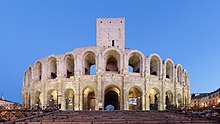
Back مسرح روماني Arabic Amfiteatr Azerbaijani Амфітэатр Byelorussian Амфитеатър Bulgarian Amfiteatr Breton Amfiteatar BS Amfiteatre Catalan Amfiteátr Czech Amffitheatr Welsh Amfiteater Danish


An amphitheatre (U.S. English: amphitheater) is an open-air venue used for entertainment, performances, and sports.[2] The term derives from the ancient Greek ἀμφιθέατρον (amphitheatron),[3] from ἀμφί (amphi), meaning "on both sides" or "around"[4] and θέατρον (théātron), meaning "place for viewing".[5][6]
Ancient Greek theatres were typically built on hillsides and semi-circular in design. The first amphitheatre may have been built at Pompeii around 70 BC.[7] Ancient Roman amphitheatres were oval or circular in plan, with seating tiers that surrounded the central performance area, like a modern open-air stadium. In contrast, both ancient Greek and ancient Roman theatres were built in a semicircle, with tiered seating rising on one side of the performance area.
Modern English parlance uses "amphitheatre" for any structure with sloping seating, including theatre-style stages with spectator seating on only one side, theatres in the round, and stadia. They can be indoor or outdoor.
- ^ Michel Tournier, Le coq de bruyère, W. D. Redfern, Fairleigh Dickinson Univ Press, 1996, p. 69
- ^ Britannica Concise Encyclopedia (1 ed.). Encyclopaedia Britannica, Incorporated. 2006. p. 64. ISBN 9781593394929.
- ^ ἀμφιθέατρον, Henry George Liddell, Robert Scott, An Intermediate Greek-English Lexicon, on Peseus
- ^ ἀμφί, Henry George Liddell, Robert Scott, A Greek-English Lexicon, on Perseus
- ^ θέατρον, Henry George Liddell, Robert Scott, A Greek-English Lexicon, on Perseus
- ^ Hoad, T.F. (1996). The Concise Oxford Dictionary of English Etymology. Oxford University Press. pp. 14, 489. ISBN 0-19-283098-8.
- ^ Grout, James. "The amphitheater at Pompeii". Encyclopaedia Romana. Retrieved 24 January 2024.